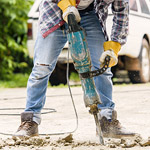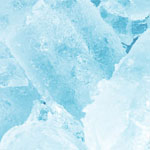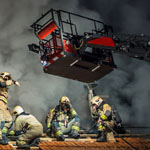18 October 2018  If you work with concrete breakers, hammer drills, chipping hammers, chainsaws and any other piece of equipment that causes high energy vibration, you're at risk of developing Hand Arm Vibration Syndrome (HAVS). Initially known as Vibration White Finger (VWF), the government have estimated that there are up to 288,000 suffers in the UK alone. This article explains the dangers of HAVS, demonstrating who should be concerned, and what steps you can take to prevent it. |
2 October 2018  You may be familiar with the old TraffiSafe System, a simple colour-coordinated cut-resistant measuring system that allowed users to easily identify what colour gloves meet what level cut-resistance. Unfortunately, all good things must come to an end, and the old standard, EN 388:2003, has been replaced with a new standard, EN 388:2016, meaning that a new TraffiSafe System is required. This short guide explains how the TraffiSafe System has been revised, ensuring that you aren't lost when it comes to cut protection. |
1 Comment15 March 2018  We recently published a post about the changes to chemical resistance testing standards with the revision of EN 374:2003 to EN 374:2016. At the same time that these standards were changed, EN 388:2003 – the specific standards used to regulate the mechanical protection provided by safety gloves – was also updated. As with EN 374, the revised EN 388:2016 requires that gloves undergo more rigorous and more comprehensive testing to promote greater user safety. Read our summary of the major changes to help you get to grips with the new markings. |
13 August 2015  It’s safety first at Safety Gloves, where we don’t settle for anything less than you total protection, there’s not many people we know who share our enthusiasm, but we reckon your EN 455 glove-wearing doctor is probably one of them. |
12 August 2015  If you're using a glove for medical purposes, it's crucial to know whether they are up to scratch. But with so many gloves out there, how do you find the best for your specific needs? With EN 455 you have an easier way to compare your single use medical gloves and know that they have been found up to the task. |
11 August 2015  If your hands are heading for a chill then you’ll be needing a pair of gloves, so get the best gloves for cold protection - not that we’re ones to brag, but the European Safety Council agrees, because all our best cold resistant gloves come with EN 511 accreditation. We've got gloves that can take on the coldest conditions science can throw at them, or just the bite of a British winter, so here's our run-down of insulated gloves to keep your hands heated when the temperature drops! |
11 August 2015  You might have seen us mention EN Standards on our website and been thoroughly confused. Worry not, as we're here to help! EN Standards are the precautions taken to ensure that your gloves work in the way that they are supposed to. We've made this infographic to help with clarifying some of the finer points of the EN standards, helping make sure that you get the gloves you need. |
15 July 2015  EN 374 can be a bit confusing, but it's crucial when it comes to purchasing your Chemical Resistant Gloves. Learn about EN 374 and where to buy your EN 374 gloves with this guide. |
11 June 2015 | Alex  Risking your life going into burning buildings and dealing with fires for the protection of others is one of the bravest things that a person can do. Ensuring that people who deal with fire are protected from its effects is of the highest importance and when it comes to using the right protective equipment, you can't take chances. Luckily, we live in a world where all of our products have been rigorously tested to ensure that they provide the protection that you need — these professional certifications provide you with piece of mind that your equipment is up to snuff. |